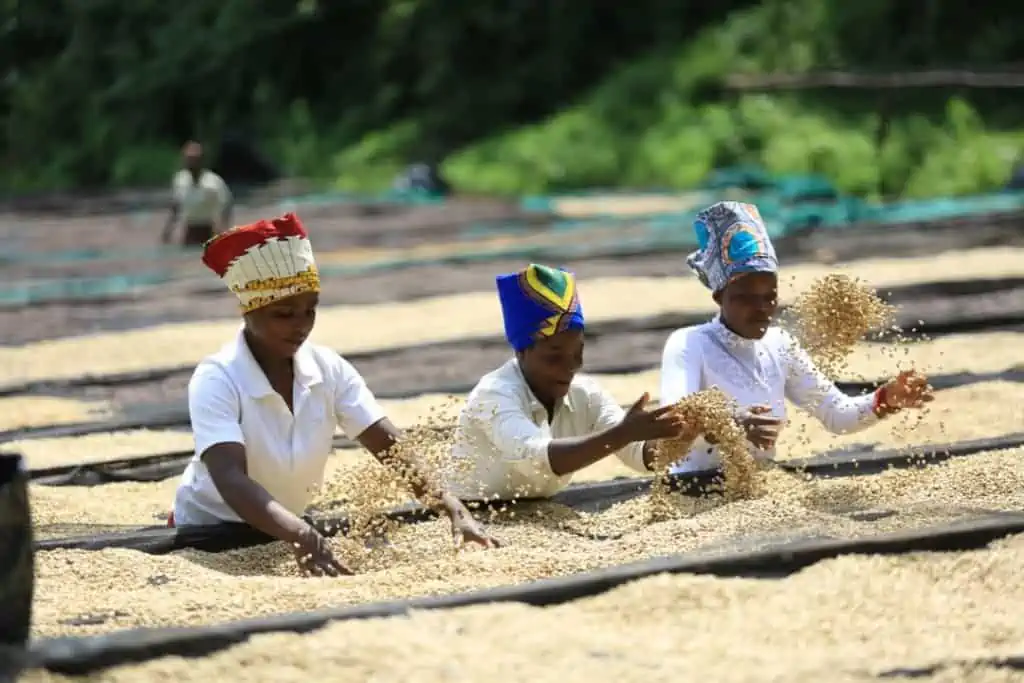
Coffee drying on raised beds in Nyaruguru District, Rwanda. Courtesy of Kakalove Cafe.
By now, most readers of Coffee Review are familiar with the win-win-hypothesis of specialty coffee: If consumers pay more for better coffee from dedicated producers, and if some of the high prices paid by consumers make it back to those producers, they will be encouraged to generate even better coffees, which will please even more consumers, who will gratefully continue to pay higher prices, and everyone, from farmer to consumer, will benefit. This is roughly the hypothesis upon which Coffee Review was founded in 1997, and it remains central to our mission.
This report is not the place to evaluate this hypothesis or its overall success, but in regard to the impact on producers, it is important to note that accumulating statistical evidence suggests that North American specialty coffee roasters do pay significantly higher prices for the coffees they buy than does the commodity coffee industry. In other words, some of the higher prices Coffee Review readers pay for today’s fine specialty coffees do make it back to producers.
The reason for bringing up the specialty coffee win-win hypothesis in the context of this report is to argue that it is nowhere as crucial as with the coffee-growing societies we feature in this report, those in the heart of Africa situated around and near the immense 1500-mile-long string of Africa’s great lakes that form the source of the Nile river. The coffees from this region are largely grown at high elevations and they come from admired tree varieties prevalent in the region for decades. Origins include the tiny but coffee-rich countries of Rwanda and Burundi, the nearby Kivu region of the Democratic Republic of the Congo (DR Congo), and parts of Tanzania, Uganda and Malawi.
Some of these societies are among the most impoverished in the world, and coffee, usually produced on tiny plots averaging fewer than four or five acres, is a desperately needed lifeline. Specialty coffee is also a crucial vehicle for economic cooperation among competing, often warring, social groups. The spectacular long-term success of the USAID-funded PEARL project aimed at rebuilding genocide-ravaged Rwanda through improving its coffees and positioning them at the high end of the specialty market is often cited as one of the main reasons the Hutu and Tutsi factions in Rwanda now maintain a largely peaceful, productive coexistence after decades of strife and tension.
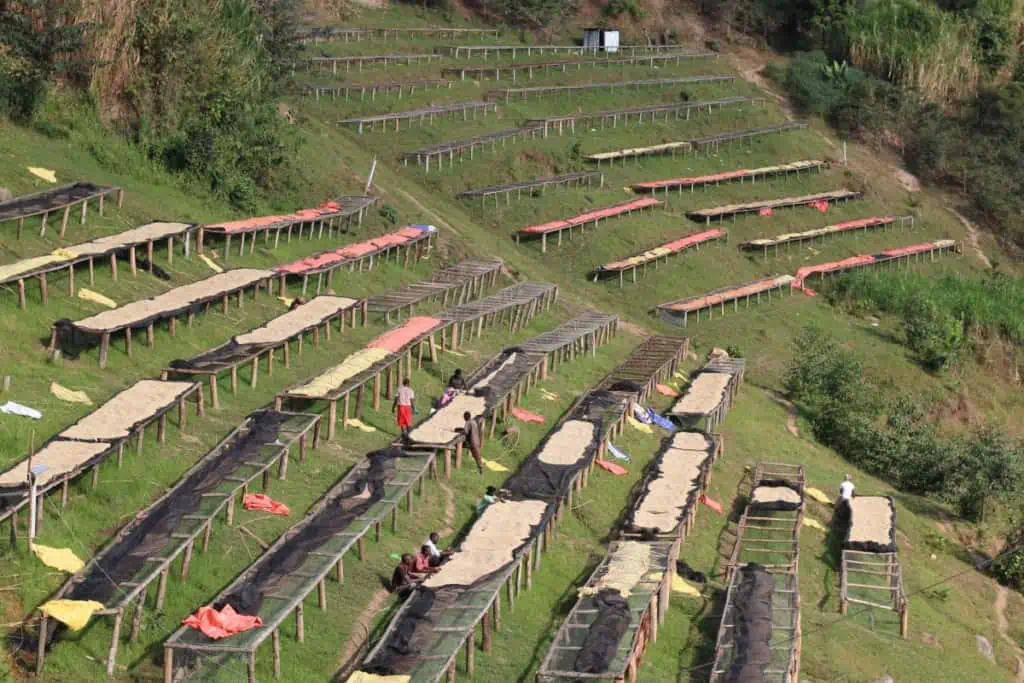
Kabirizi washing station, COOPAC Cooperative, Rwanda. Courtesy of Cafe Imports.
True, traceable coffees from single farms of the kind we are familiar with from Latin America are rare in most of these African coffee-growing regions. Coffee is usually brought by smallholding farmers to mills (called washing stations). There, the coffees are bulked together in lots by experienced mill operators who are either members of the cooperative operating the mill or knowledgeable managers familiar with local farms and farmers. Despite the relative anonymity of individual farmers, the lots coming from the best mills are often exceptional, sometimes extraordinary, and certainly worthy of admiration and prices to match their excellence.
Lots of Samples, Impressive Ratings
We tested 75 Great Lakes coffees for this report. The greatest number by far were produced in Rwanda (36 samples; average rating 90.6, low 81, high 94) followed by Burundi (18 samples; average rating 89.9, low 87, high 93). DR Congo and Tanzania supplied fewer samples but still generated impressive ratings. We tested six samples from DR Congo (average 89.3, low 85, high 94) and eight from Tanzania (average 90.1, low 86, high 94). Only Uganda and Malawi lagged, with very few samples.
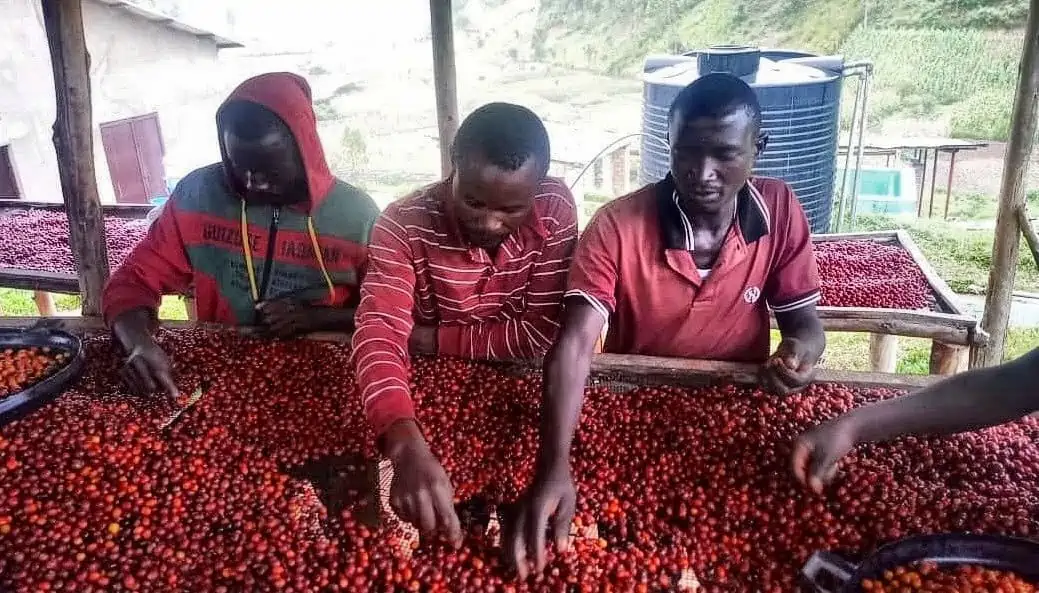
Sorting just-picked cherries in Nyaruguru District, Rwanda. Courtesy of Kakalove Cafe.
Fine Coffees, Devastating Setback in DR Congo
However, specialty coffee’s promise of better lives and greater social stability for the region’s smallholding producers is an often fragile undertaking. This was made starkly clear just three weeks before the publication of this report by the devastating eruption of the volcano Nyiragongo in the Kivu region of the DR Congo. The eruption struck at the heart of one of specialty coffee’s most inspiring recent success stories. Over the past decade, a range of agencies has led an increasingly successful push to develop fine coffee in the Kivu region. The eruption, which occurred without warning, displaced several hundred-thousand people, many of them coffee producers who were just achieving a modicum of stability in this region long tormented by ethnic violence.
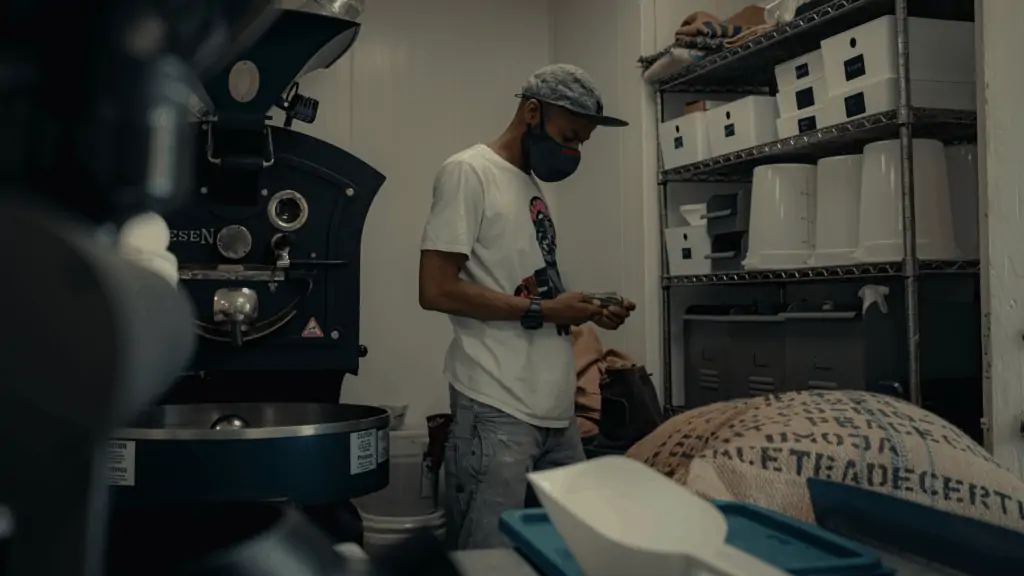
Tio Fallen of Houston-based Three Keys Coffee preparing to roast “Congo Square.” Courtesy of Rob Sykes.
The six samples we cupped from Kivu for this month’s report averaged a rating of nearly 90 and include the superb 94-rated Three Keys Congo Square reviewed with this report. The Three Keys sample displayed a strikingly original wet-processed profile, simultaneously intensely sweet, vibrantly tart and deeply savory all at once, with an intriguing juxtaposition of pistachio-like nut and sweet honey. Those interested in other variations of the Congo cup might look for the Joe Bean Congo Umoja or the Fieldheads Democratic Republic of the Congo, both 90-rated, though not formally reviewed for this month’s report.
Recovery in the Kivu region will doubtless be slow; immediate help is needed. If, in addition to supplying indirect long-term support by buying DR Congo coffee, readers are inclined to help directly, here are two relevant programs now active on the ground aiding those displaced by the eruption.
On the Ground is a non-profit that supports smallholding coffee farmers in the DR Congo and Chiapas, Mexico regions. It is in part supported by Coffee Review advertiser Amavida Coffee Roasters and regular submitter Wonderstate (formerly Kickapoo) Coffee. On the Ground is offering immediate emergency help to those displaced by the eruption from its headquarters in the coffee town of Minova. Along with other charitable non-profits, Save the Children is working on an emergency basis directly in the region.
The Classic Great Lakes Washed Cup: Deep, Sweet-Savory, Cocoa and Flowers
It is reassuring, perhaps, to report that the classic washed cup from these origins, particularly from Rwanda, Burundi and DR Congo, has not been completely submerged in a torrent of cup-altering processing experiments of the kind that are rippling through the coffee-growing regions of the world. It is a cup distinguished by a savory-sweet depth and richness, with occasional nutty or starchy undertones, but almost always with cocoa-toned chocolate leanings and surprising grace notes of flowers and dried fruit. We tested many satisfying variations of this cup from multiple roasters that we rated solidly in the 89 to 91 range. Reasonably priced, always with some little sensory surprise hidden among the more familiar aromatics, these are excellent choices for everyday drinking, particularly when they are in season from roasters, usually spring and early summer in the global north.
For two particularly fine renditions of the style, see our reviews here of the cocoa- and floral-toned Big Creek Rwanda Rulindo Tumba (94) and the similarly deep, chocolaty and floral Kakalove Rwanda Akagera CWS (93), the latter complicated by a shimmer of tart citrus.
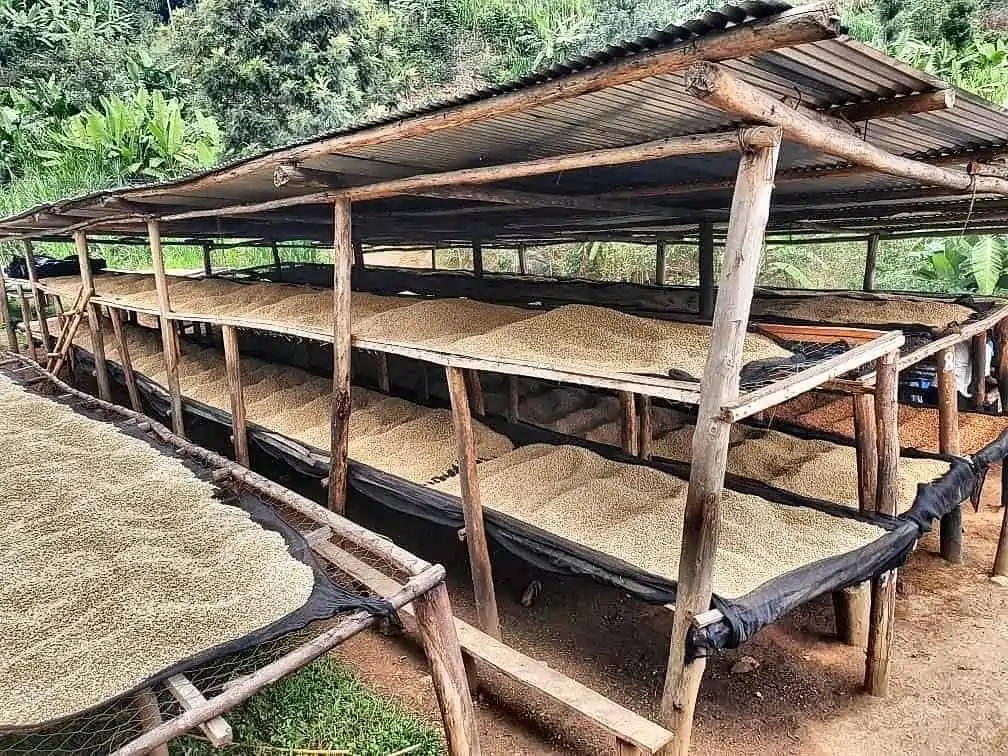
Coffees of the Akagera Project in Nyaruguru District, Rwanda, in various stages of the drying process. Courtesy of Kakalove Cafe.
Most coffees from the Great Lakes origins are produced from variants of Bourbon-derived varieties long grown in the region. It may not be fanciful to relate the sweet-savory, floral and cocoa tendencies of Rwanda and Burundi coffees in particular to this Bourbon heritage. As for processing, many mills in the Great Lakes region, as well as in Kenya, practice a particularly complex version of the washed process, in which freshly skinned fruit is first subject to a ferment step with no added water (“dry” ferment), then washed, then fermented a second time with clean water added to the tank, before being washed still again. The impact of these procedures on the sensory style of these coffees has not, to my knowledge, been systemically investigated or even much discussed, but I would guess that these practices may have something to do with the regional tendency to low-toned yet deeply expressed complexity.
The Potato Defect
Rwanda coffees, in particular, are haunted by this taint — the sudden, disconcerting aroma and flavor of raw potato. Apparently, the defect is set off by bacteria (Pantoea coffeiphila) introduced under the skin of the coffee fruit via a species of stinkbug called antestia. The bacteria cause a compound to develop around the bean that produces the powerful and memorable raw potato taste. A single fully potato-tainted bean can spoil an entire brew batch. Remarkably, among the 60-some coffees we tested from regions affected by the taint, we ran into no full-on potato cups, as we call them. This is a tribute to careful farm management and to careful examination of freshly washed coffee. Beans carrying this taint evidently can be identified only by visual examination when the coffee is still in its wet parchment, fresh from washing, and the tainted beans must be picked off the drying tables by hand, one by one.
Impact of Alternative Processing Methods
Like coffee producers all over the world, many mills in the Great Lakes regions are experimenting with alternative processing methods. The goal is to differentiate their coffees from the regional wet-processed norm I described earlier and to attract more attention and higher prices from buyers. True, the Great Lakes producers do not appear to be taking as many processing shots in the dark as their counterparts are doing in Central America and elsewhere. For example, we had no samples whatsoever processed using the experimental anaerobic ferment techniques increasingly popular in Latin America and Ethiopia. (See our May 2021 report, Fun With Ferment: Anaerobically Processed Coffees.)
We did test quite a few natural-processed samples, however (beans are dried in the entire fruit), and a handful of honey-processed coffees (the skin of the fruit is removed but at least some of the sticky fruit flesh is allowed to dry on the beans). The Great Lakes naturals we tested struck me as rather traditional given their processing method. They tended to aim unapologetically for the big-time sweet fruit and chocolate potential of the method. We review here two of the successes, the Rwanda Kinini Village Natural from PT’s Coffee (94; juicy sweet, blueberry pie) and the Rwanda Dukunde Kawa from Black Oak Coffee (93; dark chocolate, crisp and fragrantly cedary).
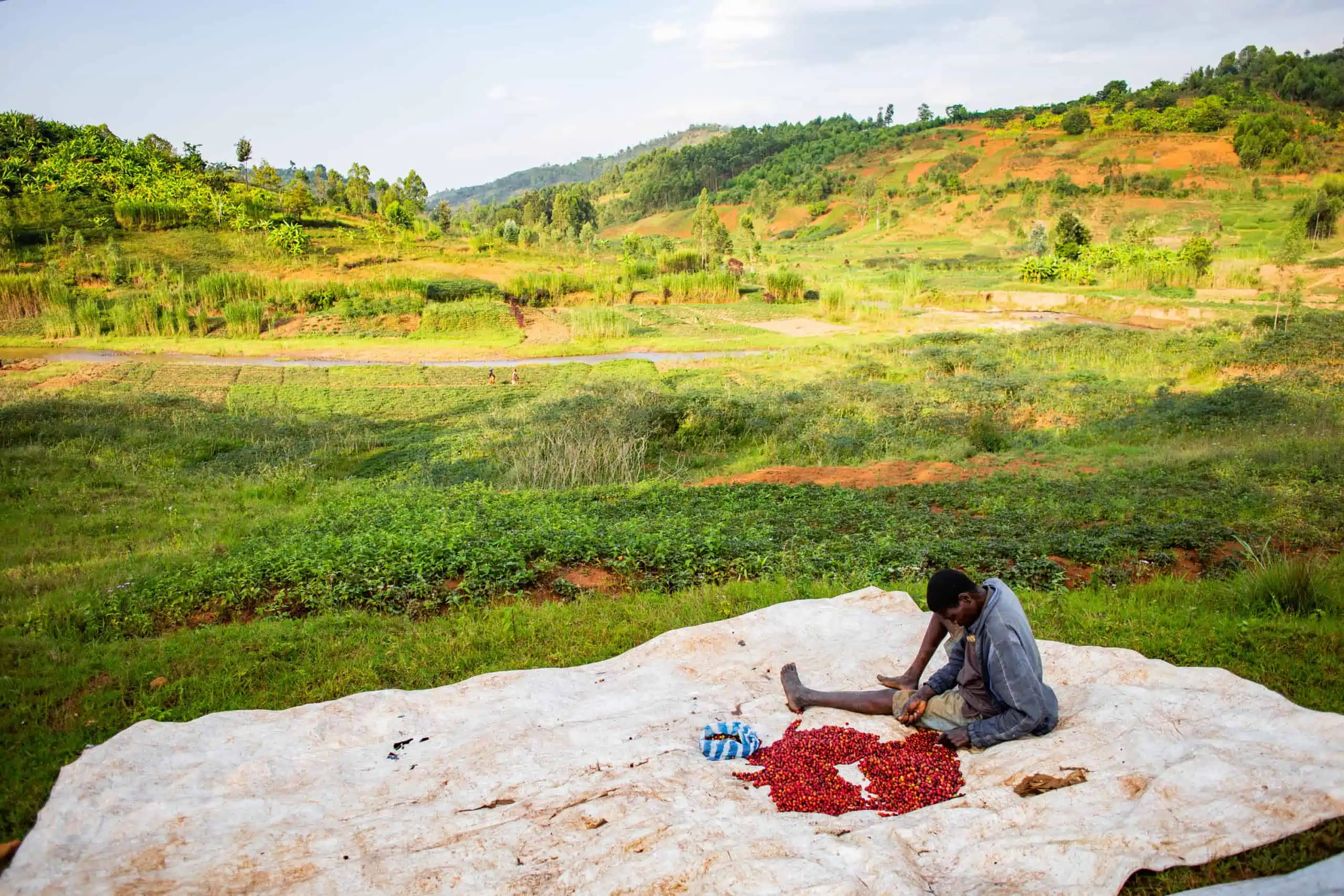
Sorting cherries for the Long Miles Coffee Project in Kayanza State, Burundi. Courtesy of Oliver Stormshak.
If the drying is not handled well with honey coffees, profiles can end rather rough, even musty. However, the two honey-processed samples we review here were particularly graceful examples of the style. The Olympia Coffee Burundi Mikuba Honey (93) is round, balanced and crisply sweet, with subtly original aromatics (spicy flowers, apricot). The very light-roasted Mamechamame Coffee Rwanda Simbi (93) is delicately brisk and lightly tart with pomegranate suggestions.
The Roast Card
Most coffees we test over the course of a year are light-medium to medium in roast, reflecting each individual roaster’s personally calibrated goal of fully developing the character of the bean while leaving behind neither a distracting scorchy edge nor the grassy, nutty hints of an underdeveloped roast. This month, however, we review one successful darker roast, the Valverde Burundi Kinyovu (92; sweetly roast-toned, roundly pungent and chocolaty), and one very light roast, the Mamechamame Rwanda Simbi (noted above, brisk and sweetly tart).
The Tanzania Exception
Tanzania, the large country south of Kenya, bordering Rwanda and Burundi on the west and the Indian Ocean on the east, is a producer that, unlike its northern neighbors Kenya and Ethiopia, has never quite broken into the specialty coffee big time. It is blessed with a variety of excellent coffee terroirs and large plantings of traditional, subtly distinctive Bourbon-related varieties of Arabica. It also benefits from a peculiar marketing advantage (or perhaps limitation) bestowed on it by coffee tradition. “Tanzania peaberry” is an arbitrary sort of specialty coffee “brand.”
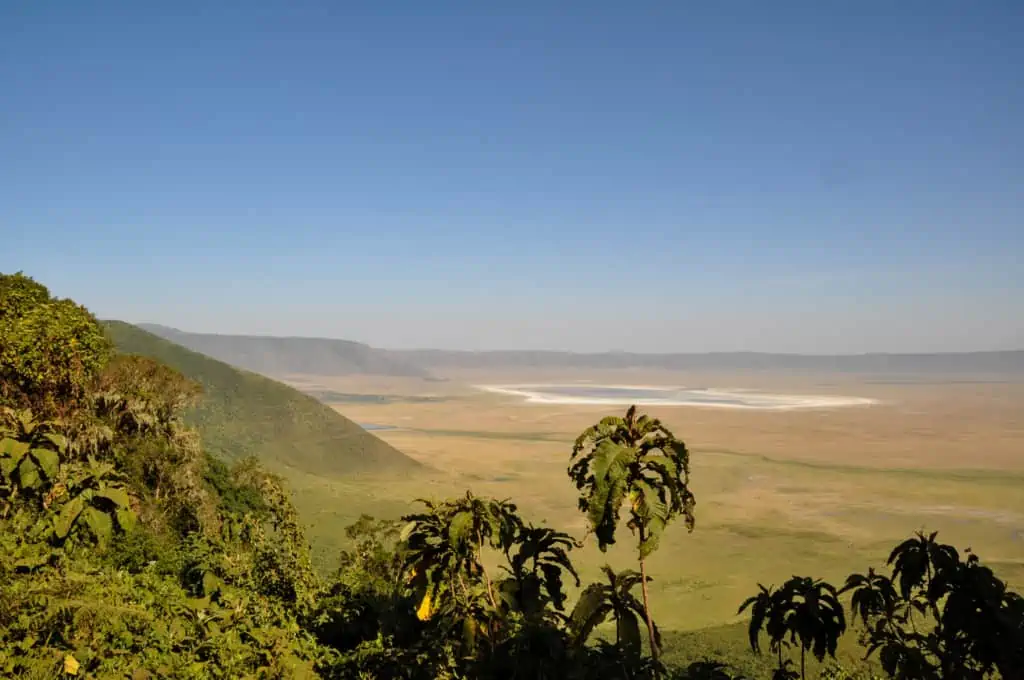
The landscape surrounding Sambewe AMCOS Cooperative in Songwe Region, Mbozi District, Tanzania. Courtesy of Cafe Imports.
Peaberries, of course, are a grade of coffee produced everywhere that coffee is grown, yet for reasons that are not entirely clear, Tanzania is particularly associated with its peaberry grades. In other words, all coffee origins produce peaberries, but of all coffee-producing countries of the world only Tanzania seems to be particularly identified with them. In the early days of specialty coffee, “Tanzania peaberry” was a standard, almost requisite offering in specialty stores, and it continues to appear on specialty coffee menus and websites, though with less frequency than it once did.
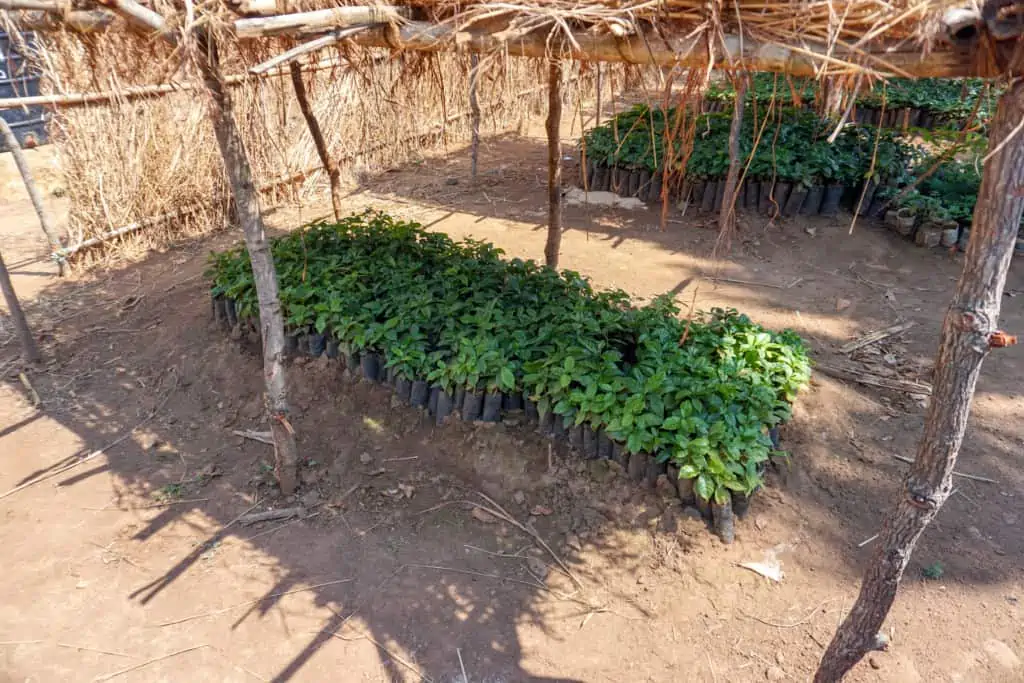
The nursery at Sambewe AMCOS Cooperative in Songwe Region, Mbozi District, Tanzania. Courtesy of Cafe Imports.
We review one Tanzania peaberry this month, an excellent one, the Volcanica Tanzania Peaberry (94). It was produced in northern Tanzania, toward the border with Kenya, and perhaps for that reason its suave balance and juicy character are rather Kenya-like, with aromatics built around pungent fruit (black currant, pink grapefruit) and lush flowers. The other impressive Tanzania we review, also a washed coffee, the Lexington Tanzania Sambewe (94), is high-toned, richly juicy and sweetly bright. If neither of these profiles quite sound like the rounder, more savory Great Lakes profile I generalized about earlier, it is because Tanzania is a bit of a coffee world apart. We include its usually brighter, higher-toned coffees here for expediency (otherwise Tanzania tends to get left out of our reports), and for its geography, since much of its long western border runs through or next to the shores of two of the greatest of the Great Lakes, Tanganyika and Malawi.
Nevertheless, as with other origins we highlight in this report, Tanzania producers, often smallholders organized in cooperatives or working in collaboration with a mill, are deserving of our attention and support — as are all of the farmers, mill operators and their exporter, aid agency and roaster partners who are busy elevating the coffee societies of the Great Lakes region from anonymity to distinction.










